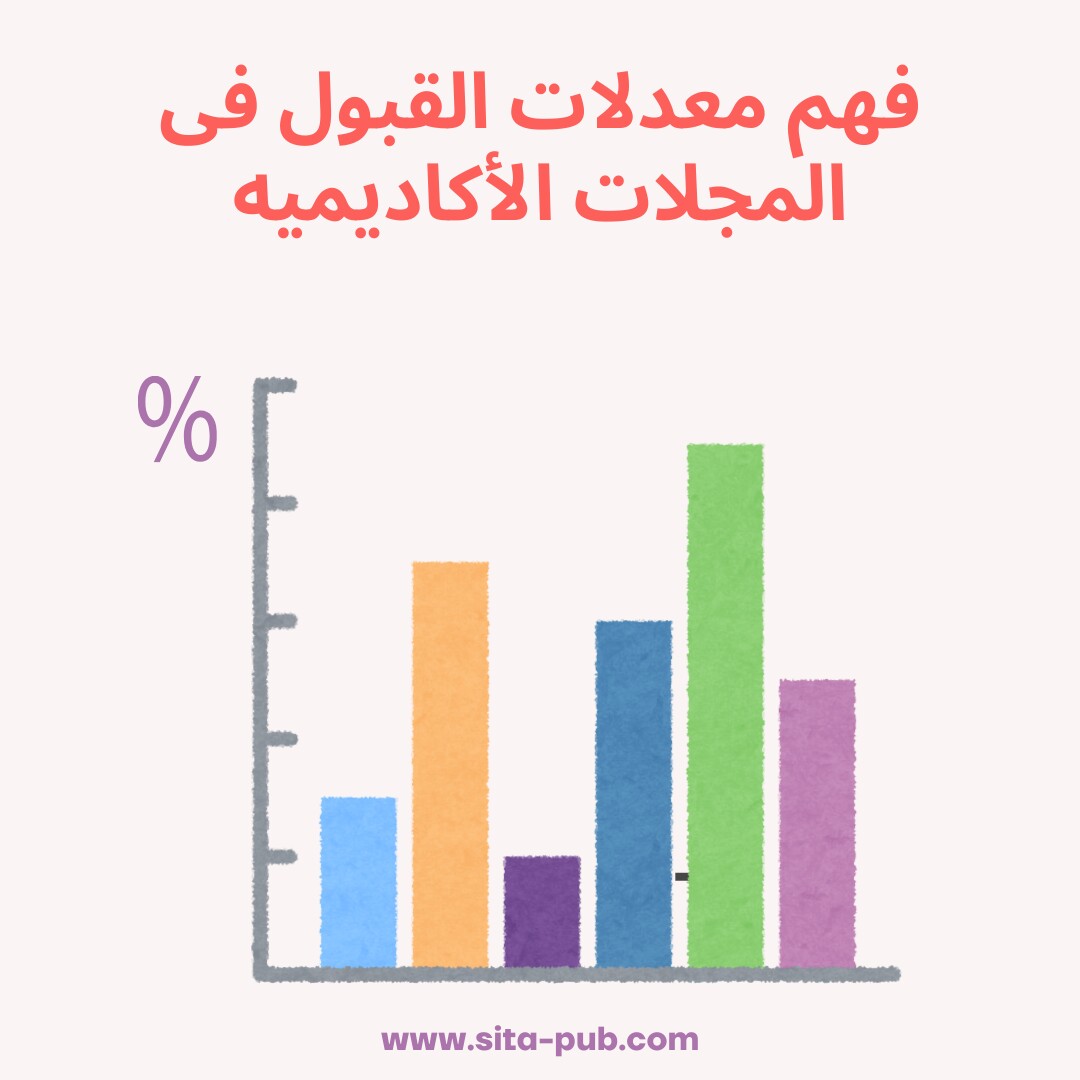فهم معدلات القبول فی المجلات الأکادیمیه


معدلات القبول فی المجلات الأکادیمیه هی أرقام مهمه تشیر إلى عدد الأوراق التی تم قبولها للنشر من بین الأوراق المقدمه. بالنسبه للباحثین والکتاب، معرفه هذه المعدلات یمکن أن تساعد فی اتخاذ قرار بشأن اختیار المجله للنشر. یشرح هذا المقال ما هی معدلات القبول، والعوامل التی تؤثر فیها، کیف تختلف بین المجلات، ولماذا تهم الکتاب فی المجال الأکادیمی.
معدل القبول هو النسبه المئویه للأوراق التی تقبلها المجله. یتم حسابه عن طریق قسمه عدد الأوراق المقبوله على إجمالی عدد الإرسالات. على سبیل المثال، إذا تلقت مجله 100 إرسال وقبلت 10، فإن معدل القبول هو 10%. یساعد هذا الرقم الکتاب على فهم مدى تنافسیه المجله ویمکن أن یؤثر فی قرارهم بشأن مکان تقدیم أبحاثهم.


هناک عده عوامل تؤثر على إحصائیات معدلات قبول المجلات:
سمعه المجله: تعتبر المجلات ذات التأثیر العالی، التی تحظى بالاحترام الکبیر فی مجالاتها، عادهً لدیها معدلات قبول منخفضه. تتلقى هذه المجلات العدید من الإرسالات وتحافظ على معاییر جوده صارمه لضمان نشر أفضل الأبحاث فقط.
مجال الدراسه: یمکن أن تختلف معدلات القبول بشکل کبیر حسب مجال الدراسه. تمیل المجالات المعتمده بالعدید من الإرسالات إلى وجود مجلات تنافسیه أکثر، بینما قد تکون لدى المجالات الناشئه معدلات قبول أعلى حیث تسعى إلى البحث الأساسی.
نوع المجله: یمکن أن تختلف معدلات القبول بین أنواع المجلات المختلفه، مثل المجلات ذات الوصول المفتوح والمجلات التی تعتمد على الاشتراکات. فهم تأثیر معدلات القبول یمکن أن یوجه الکتاب فی اختیاراتهم، حیث تهدف المجلات ذات الوصول المفتوح غالبًا إلى زیاده رؤیه البحث وإمکانیه الوصول إلیه، مما یؤدی إلى معدلات قبول أعلى.
سیاسه التحریر: قواعد وعملیات المجله یمکن أن تؤثر أیضًا على معدلات القبول. قد تعطی بعض المجلات الأولویه لأنواع معینه من الدراسات أو الأسالیب، مما یؤثر على ما یتم قبوله.
الجداول الزمنیه للقبول: معظم المجلات لا تنشر جداول زمنیه للقبول، وعندما تفعل، قد لا تکون المعلومات دقیقه. یمکن أن تجعل هذه النقص فی الشفافیه من الصعب على الکتاب تقدیر مدى طول عملیه المراجعه.
أمثله على ذلک تشمل مجله Nature ومجله The Lancet. ترکز هذه المجلات على نشر الأبحاث الجدیده الهامه وعادهً ما تکون لدیها معدلات قبول منخفضه جدًا، غالبًا ما تتراوح بین 5-10%.
هذه المجلات، مثل مجله Journal of Applied Psychology، لدیها معاییر عالیه ولکنها تقبل مجموعه أوسع من الأبحاث ذات الجوده، مع معدلات قبول تتراوح حوالی 15-25%.
المجلات التی ترکز على مواضیع محدده، مثل مجله Journal of Rural Studies، قد تقبل المزید من الأوراق بسبب جمهورها الخاص، وغالبًا ما تکون لدیها معدلات قبول تتراوح بین 20-30%.
مجلات مثل PLOS ONE تهدف إلى زیاده رؤیه البحث وغالبًا ما تکون لدیها معدلات قبول تتراوح بین 30-50%، مما یجعلها جاذبه للعدید من الباحثین.
کثیر من المجلات لا تنشر معدلات قبولها لأنها تخشى أن تکون معدلات القبول المنخفضه قد تثیر الإحباط لدى الکتاب وتثنیهم عن تقدیم أعمالهم. یرفض المحررون الأوراق لأسباب متنوعه، بما فی ذلک عدم الجدیه، وعدم کفایه الأسلوب البحثی، أو سوء جوده الکتابه. غالبًا ما یقدمون تغذیه راجعه مفیده للکتاب لتحسین الإرسالات المستقبلیه. فهم عملیه تقدیم ورقه البحث یمکن أن یساعد الکتاب على التحضیر بشکل أفضل للرفض المحتمل وزیاده فرص قبول أبحاثهم فی المستقبل.

یعد فهم معدلات القبول أمرًا أساسیًا للکتاب لعده أسباب:
اختیار المجله: یساعد معرفه معدلات القبول الکتاب على اختیار المجلات التی تتماشى مع جوده أبحاثهم وأهدافهم.
التخطیط الاستراتیجی: یمکن للکتاب تخطیط إرسالاتهم بشکل أکثر فعالیه. على سبیل المثال، قد یختارون مجله تتمتع بمعدل قبول أعلى للنتائج الأولیه ویهدفون إلى المجلات ذات التأثیر العالی للدراسات الأکثر أهمیه.
إداره التوقعات: یساعد الوعی بمعدلات القبول الکتاب على إداره توقعاتهم. فهم معدل قبول منخفض فی مجله معینه یمکن أن یعد الکتاب للرفض المحتمل ویشجعهم على طلب تعلیق راجعه للتحسین.
تعتبر معدلات القبول فی المجلات الأکادیمیه مقاییس حیویه تظهر مدى انتقائیه المجله. من خلال النظر فی إحصائیات معدلات قبول المجلات بالإضافه إلى عوامل أخرى، یمکن للکتاب اتخاذ قرارات مستنیره حول مکان تقدیم أعمالهم. فهم هذه العناصر یساعد الکتاب على التنقل بفعالیه أکبر فی عالم الکتابه الأکادیمیه والنشر. سواء کانوا یقدمون إلى المجلات ذات التأثیر العالی أو المجلات المتخصصه، فإن معرفه هذه العوامل یمکن أن تؤثر بشکل کبیر على النجاح وتعزیز مسیره الباحث فی الأکادیمیه.
إذا کنت تبحث عن قائمه شامله من المجلات الأکادیمیه للاعتبار فی أبحاثک، فنحن هنا لمساعدتک! تواصل معنا الیوم، وسنقدم لک المعلومات التی تحتاجها لاتخاذ قرارات مستنیره حول مکان تقدیم بحثک.
إذا کان لدیک أی أسئله، استفسارات، أو ترغب فی معرفه المزید عن خدماتنا، فلا تتردد فی التواصل معنا. فریقنا المخصص مستعد لمساعدتک.